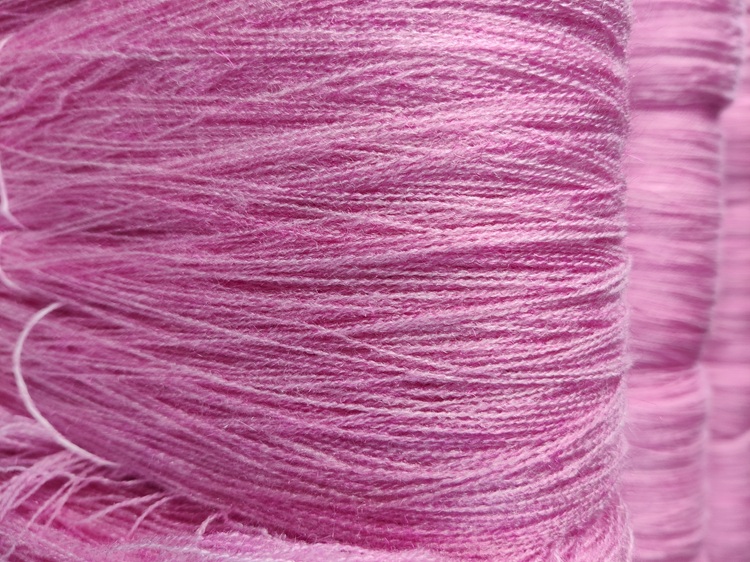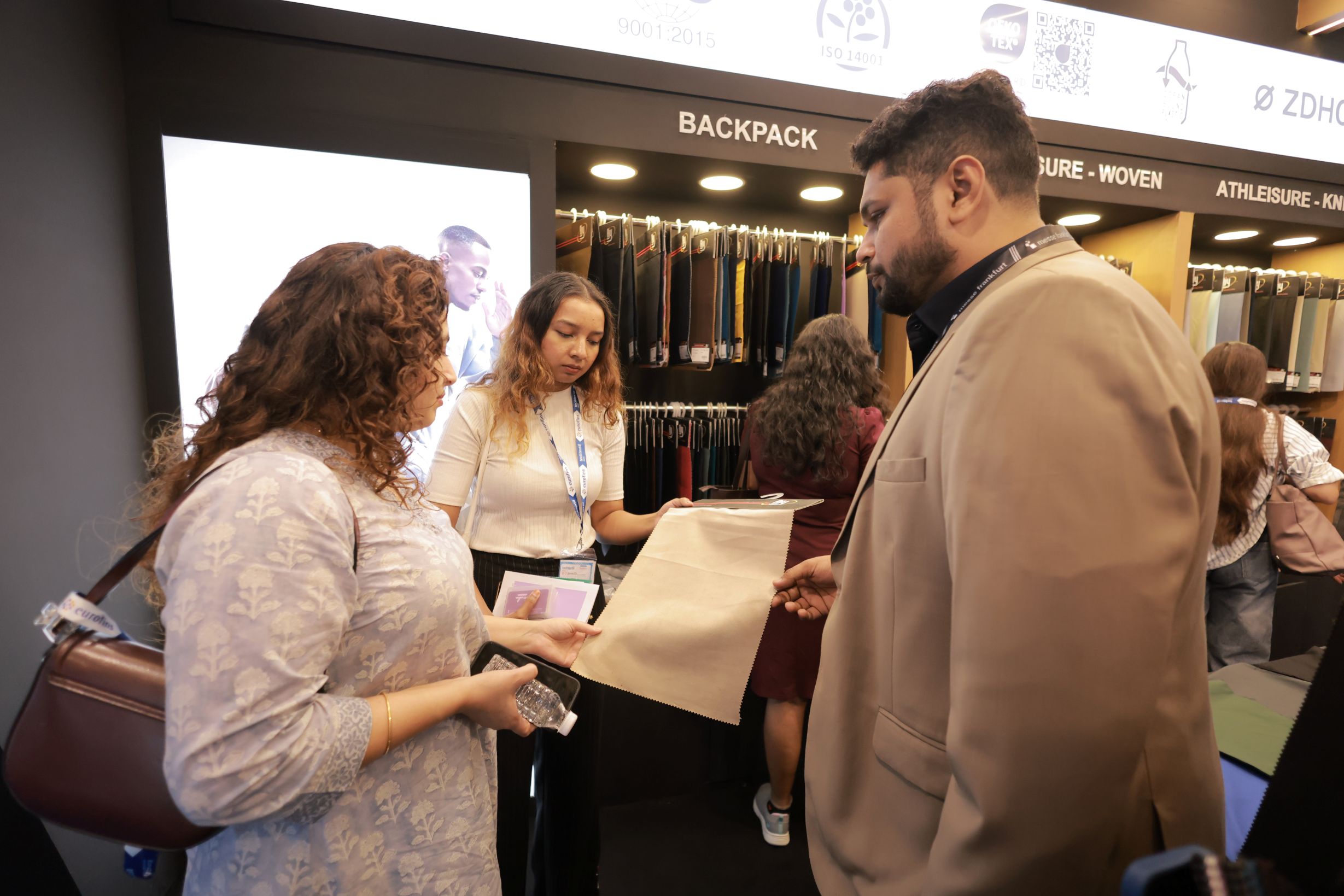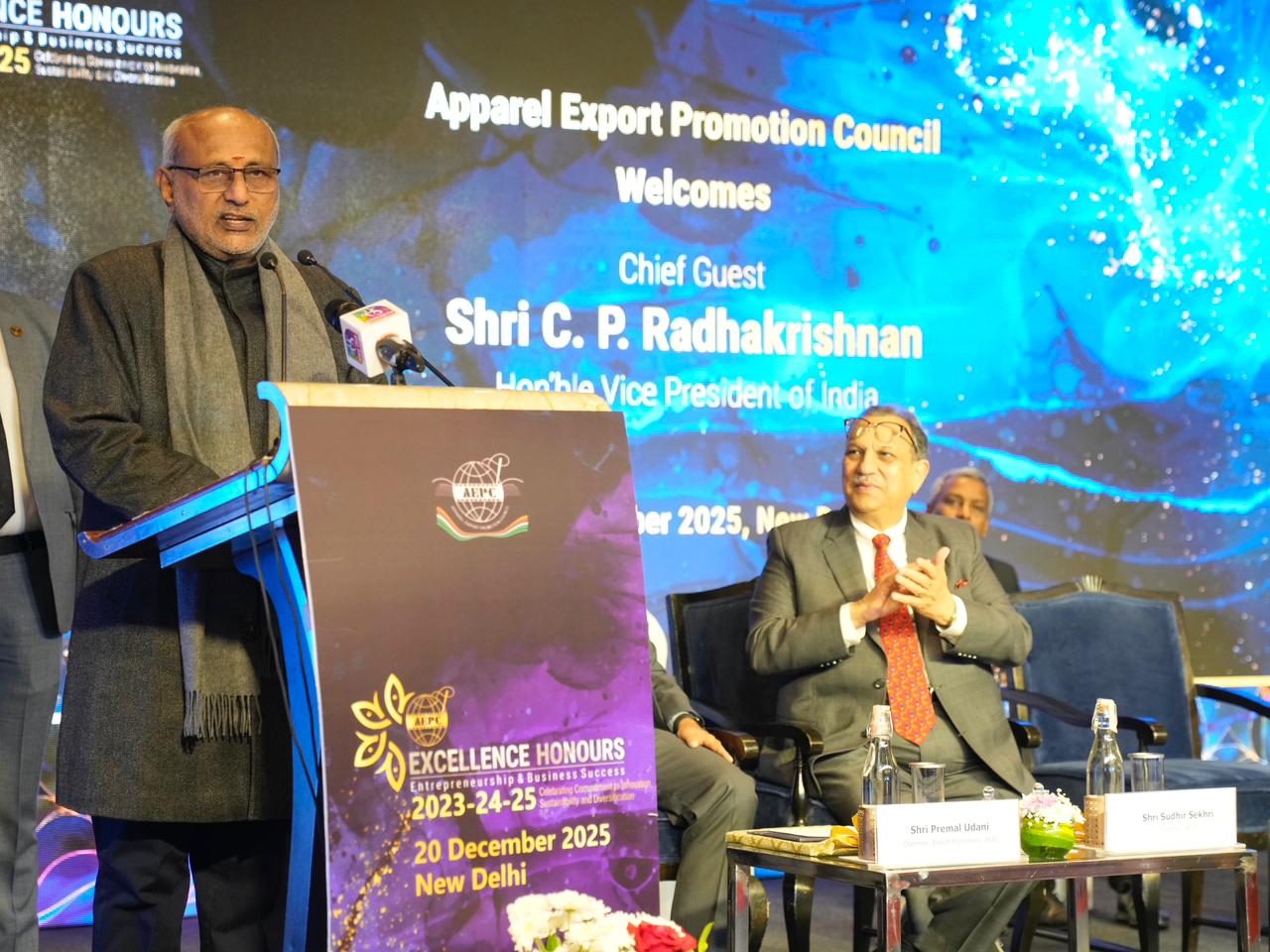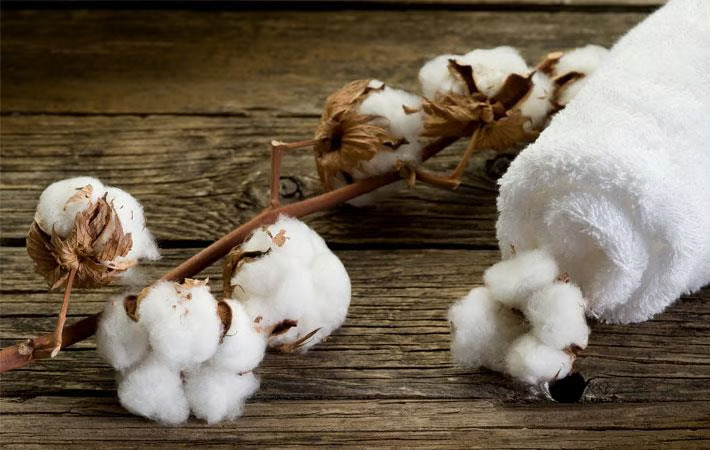FW
UK’s leading fashion and lifestyle trade show, Scoop is returning to Olympia National from February 8–10, 2026, with a strong focus on discovery, welcoming an exciting roster of new global designers.
Recognized for its gallery-like atmosphere, premium edit, and ability to introduce labels before they break into the wider market, Scoop remains the definitive destination for fashion buyers seeking fresh talent and originality.
The new wave of UK and international talent at the trade show has been personally selected by Karen Radley, Founder and Curator. The show features several first-time exhibitors this season. These include Belsize 25, Girlfriend Collective, Par Y Escala, CCDK, Lalide a Paris, The Keep and Van Den Abeele. These new exhibitors offer an invigorating mix of aesthetics, from beautifully crafted contemporary womenswear to distinctive lifestyle pieces.
Scoop’s commitment to presenting emerging talent ensures that buyers encounter something truly original and commercially compelling each season. With its intimate layout and design-led presentation, the show provides the clarity and inspiration retailers need to confidently curate their collections.
The upcoming edition promises a dynamic and inspiring showcase, reinforcing Scoop's position as the UK’s primary source for new and noteworthy fashion.
Louis Vuitton appointed rising American actress Chase Infiniti as its newest House Ambassador. Born in Indianapolis, the 25-year-old has quickly become a standout performer in Hollywood following her acclaimed roles in David E. Kelley's 2024 series ‘Presumed Innocent’ and Paul Thomas Anderson’s film, ‘One Battle After Another,’ released this year.
Infiniti’s explosive debut has earned her significant recognition, including a 2025 Gotham Award nomination for Breakthrough Performer, a 2026 Golden Globe nomination for Best Performance by a Female Actor in a Motion Picture – Musical or Comedy, and a 2026 Critic’s Choice Award nomination for Best Actress. The actress is next set to appear in the sequel to ‘The Handmaid’s Tale,’ ‘The Testaments,’ scheduled for release in April next year.
Praising its new collaborator, Louis Vuitton says, Chase Infiniti perfectly embodies Louis Vuitton’s powerful and timeless femininity, reflecting the shared values that unite her with the house. Through her artistry, she brings to the house a rare balance of youthful dynamism and forward-looking vision.
This is not the first collaboration between Infiniti and the LVMH-owned brand. The actress attended the last two women’s runway show - the Fall-Winter 2025 and Spring-Summer 2026 collections - by Nicolas Ghesquière, Artistic Director of women's collections. She was also seen wearing a custom Louis Vuitton champagne satin hand-embroidered gown, inspired by an 1860 archive piece, at the world premiere of her film "One Battle After Another" in September.
Infiniti joins a star-studded global roster of Louis Vuitton ambassadors that includes major figures across fashion, music, and sports, such as Zendaya, Pusha T (under Pharrell Williams’s direction for men's), K-pop stars J-Hope, Lisa, Felix, Jackson Wang, and top athletes like Victor Wembanyama and Carlos Alcaraz.
The parent company of Zara, Bershka, and other major fashion brands, Inditex closed 132 stores globally as of October 31, 2025, according to its nine-month fiscal 2025 earnings report. The company ended the quarter with a total of 5,527 physical locations, confirming its strategy to streamline operations and enhance long-term profitability through digital and physical integration.
Inditex has been executing a large-scale modernization plan, investing approximately €900 million ($1.05 billion) annually to upgrade logistics, renovate existing units, and strategically relocate or open stores in high-traffic, high-potential areas.
Despite the overall net reduction in store count, certain brands did expand their physical presence: Lefties added 10 new stores, and Bershka opened four new locations.
The company’s optimization strategy appears to be successful on the bottom line. Total sales increased 2.7 per cent to €28.2 billion ($32.82 billion), driven primarily by strong customer satisfaction across both its in-store and online channels.
Groka Garcia-Tapia, Director-Investor Relationa, Inditex notes, the company’s store sales have been strong, online sales have been great. Early fourth-quarter results show continued momentum, with Autumn/Winter collections driving a 10.6 per cent rise in sales from November 1 through December 1.
Inditex is heavily investing in digital integration within its physical stores, highlighted by the growing adoption of self-checkout technology. Some flagship stores are reporting nearly 90 per cent of transactions processed through automated kiosks, a significant jump from 30 per cent at Zara earlier in the year.
Kate Hardcastle, Consumer Expert Contributor, Forbes notes, Inditex’s major strength is its omnichannel integration, which is critical for meeting the growing consumer demand for flexibility in how they shop. Similarly, Jon Copestake, Consumer Senior Analyst, EY Global warns, companies cutting their store footprints too drastically risk missing a significant trick, as stores remain valuable assets in the modern retail ecosystem.
The closures reflect a broader industry trend toward optimizing physical space in response to global e-commerce growth, while still acknowledging that most consumers currently prefer in-person shopping.

When ChatGPT unveiled its Instant Checkout capability allowing users to discover, evaluate, and purchase products within a single conversational interface it was more than a feature release. It was a signal that the very foundations of digital commerce are shifting. Retail’s long-standing search-and-scroll paradigm is giving way to a fluid, AI-driven shopping continuum where discovery, decision-making, and transaction collapse into a single stream of dialogue.
For decades, e-commerce was built on keywords, filters, catalogues, and comparison tabs. The consumer journey was logical but laborious. Now, with conversational AI transforming into a transactional layer, the retail experience is being reimagined as something far more human, intuitive, and anticipatory. What we are witnessing is the emergence of the world’s first ‘AI shopping mall’ a place where the storefront, the salesperson, the stylist, the cashier, and the supply chain all merge into a single generative system.
From chatbots to commerce engines
The idea of talking to a computer to shop is not new. Retailers experimented with simple chatbots almost a decade ago, but these early tools were rigid and easily confused. Today’s systems, however, are built on multimodal models that parse language, visual cues, sentiment, and context simultaneously. What was once a novelty is now an operational pillar for global retailers.
Amazon’s AI-driven recommendation engine remains one of the most sophisticated examples in the industry, contributing an estimated 35 per cent of its sales. Meanwhile, fast-fashion platform Shein has quietly built a predictive engine that analyses browsing behavior, social sentiment, and even image preferences to forecast what a customer will want weeks before they articulate it. This is personalization in its most dynamic form, where the system becomes a stylist, merchandiser, and trend predictor all at once.
What distinguishes generative AI from previous generations is its capacity to synthesize, not just retrieve answers. It doesn’t simply show what others bought; it understands the customer’s intent and constructs entirely new recommendations, outfits, or shopping journeys in real time.
The virtual fitting room goes mainstream
One of the most stubborn hurdles in online retail has been the absence of tactile experience. You cannot feel fabric, test lipstick shades, or check the drape of a dress. Yet, AI is dissolving even these barriers.
Sephora’s Virtual Artist, Google’s AI try-ons for apparel, and Amazon’s visual search tools are reshaping how consumers bridge physical imagination with digital reality. By layering facial recognition, digital draping, and real-time rendering, these tools allow shoppers to preview makeup, experiment with hair colors, or test apparel silhouettes with surprising accuracy. For retailers, the payoff is substantial: higher conversion, lower product returns, and stronger consumer confidence.
Platforms like Zalando, Myntra, and Shopify-powered brands are increasingly integrating generative visual engines that adjust product imagery to diverse body types or skin tones. This is not merely a technical upgrade; it is a cultural shift toward more inclusive commerce, where consumers finally see themselves accurately reflected online.
Content that writes itself
The retail world publishes millions of product descriptions, advertisements, and SEO assets each year. Traditionally, producing such content was a slow and expensive process. Generative AI has collapsed that cycle dramatically. Brands now use AI to spin up hundreds of product descriptions that adapt to tone, language, and context. A single piece of creative can generate countless micro-variations of ads optimized for different platforms or demographic groups. For global brands, it ensures coherence. For smaller brands, it levels the playing field by eliminating a previously costly barrier to scale.
Some retailers are already using generative models to design entire campaigns from storyboard concepts to captioned videos reducing time-to-market by weeks. In a sector defined by fast-changing trends, speed is not just an advantage; it is survival.
AI in supply chains and operations
Beyond the glossy front-end experiences lies an equally transformative story in retail’s back rooms. AI-driven demand forecasting has become the quiet backbone of inventory management. Walmart’s sophisticated models process historical sales data, local events, weather fluctuations, and economic indicators to predict what will sell and when. This helps avoid stockouts and reduces wastage critical for perishable categories but increasingly important in fashion, where overproduction has long been a structural problem.
ChatGPT-like negotiation bots now assist with supplier conversations, turning what was once a lengthy, human-led process into a streamlined, data-driven exchange. Carrefour’s digital assistant, for example, not only recommends recipes to consumers but also helps the retailer plan procurement more efficiently. Walmart’s in-store AI assistant ‘Ask Sam’ is proving how a single tool can enhance productivity for both shoppers and floor staff.
The result is a retail ecosystem where operational intelligence becomes continuous, adaptive, and increasingly autonomous.
Dawn of a new shopping paradigm
The speed at which consumers have embraced conversational search is perhaps the clearest indicator of the shift ahead. Major retailers report that customers using AI interfaces convert faster, browse longer, and purchase more items on average. Conversational commerce, once dismissed as a niche, is becoming a mainstream shopping behavior.
But the next leap will come from agentic AI, systems that don’t wait for instructions but proactively act on behalf of the user. An agentic retail AI could track a customer’s wardrobe, remind them when staples need replacing, suggest additions to maintain a capsule collection, or automatically compare prices to secure the best deal. For retailers, agentic AI can dynamically adjust pricing, personalize homepage layouts, and optimize marketing spend in real time based on user behavior. The borderlines between a search engine, a personal stylist, and a marketplace are dissolving. Retail is no longer a destination you visit; it is a service that accompanies you everywhere.
The future of retail is no longer store-led
As generative AI weaves itself deeper into every layer of the retail value chain, the industry is quietly undergoing its most significant reinvention since the rise of e-commerce. The mall is no longer a physical space or even a website. It is an intelligent, conversational network of algorithms designed to understand consumer intent and deliver solutions instantly. Retailers who embrace this shift will find themselves operating in a world where personalization is real-time, operations are self-optimizing, and the customer journey is no longer linear but continuous. Those who resist risk becoming relics of the search-and-scroll era.
The new shopping mall is already here. It is everywhere, accessible through a single conversation, and built not with glass and concrete but with generative intelligence. The question for the industry is no longer whether AI will reshape retail it is how quickly retailers can redesign themselves to thrive in an agentic, conversational, AI-first world.
The Indian government is reportedly drafting a new set of mandatory labeling rules for apparel and home textiles sold domestically.
The regulations are intended to ensure greater transparency and standardization for consumers regarding the composition and quality of textile products. Currently being finalized by the Ministry of Textiles and Bureau of Indian Standards (BIS), these new rules will likely require manufacturers to clearly display information on accurate percentages of all fibers used, standardized symbols and instructions for washing, drying, and ironing and the country of origin for the final product.
This move is a part of the government's broader initiative to improve the quality of goods sold in the domestic market, protect consumers from misleading labeling, and streamline trade standards for Indian manufacturers.
Europe’s largest fully integrated textile manufacturer, Kipas Textiles has launched a new recycling platform, fibR-e to overcome long-standing barriers that have prevented polyester from becoming truly circular.
The global fashion industry produces millions of tons of polyester-based garments each year, yet less than 1 per cent is recycled back into new apparel. The vast majority ends up incinerated or in landfill, creating what industry observers describe as a major but under-acknowledged waste crisis. With regulatory pressure increasing across Europe and beyond, brands are being held accountable for the full lifecycle of their products, while consumers are raising expectations around sustainability.
fibR-e offers brands a practical route forward. Through Turkish chemical manufacturer Meltem Kimya, post-consumer garments containing 70 per cent or more polyester — including polyester-elastane blends and other mixed-fiber compositions — are processed into high-quality, GRS-certified rTEX Chips. Items with attached trims and mixed-color feedstocks can also be accommodated. These chips are then converted by Kipas Textiles into certified filament yarns and staple fibers suitable for new collections.
The platform removes accessories during processing, reducing manual labour and eliminating key bottlenecks. It also decolourises blended fabrics to deliver cleaner outputs. Central to the system is Meltem Kimya’s patented molecular recycling technology, which breaks polyester down to its fundamental components and rebuilds it without generating microplastics, enabling repeated recycling with no loss of quality.
Early assessments indicate, producing polyester entirely from textile waste through fibR-e can reduce emissions by nearly 74 per cent compared with virgin polyester. According to Halit Gümüser, Chief Executive, Kipas Textiles, traditional recycling approaches have addressed only a fraction of polyester waste. The new platform allows genuine post-consumer waste, in all its complexity, to be returned to market as certified, high-quality yarns and fibres, representing a shift from linear to circular production at commercial scale, he adds.
fibR-e is the product of a multi-year partnership between Kipas and specialist companies, with Meltem Kimya supplying the molecular recycling capability underpinning the platform. Kipas will integrate fibR-e materials directly into its own yarn and fabric production, enabling bulk output at competitive prices. The resulting materials are traceable, performance-tested, and formulated to meet commercial standards while helping brands reduce reliance on virgin inputs and prepare for tightening regulatory requirements.
G-III Apparel Group has raised its full-year earnings forecast following better-than-expected third-quarter earnings, even as the US firm's sales declined by 9 per cent to $988.6 million.
Owner of brands including Karl Lagerfeld, Sonia Rykiel, and DKNY, the New York-based company reported net earnings of $80.6 million, or $1.84 per diluted share, for the three months ending October 31. This compares to earnings of $114.8 million, or $2.55 per diluted share, in the same quarter last year.
Despite lower profits compared to the prior-year period, Morris Goldfrab, Chairman and CEO, GIII, says, the company delivered strong Q3 results with gross margins and earnings far exceeding expectations. He attributed this performance to the strength of their ‘go-forward portfolio,’ especially their owned brands, a healthy mix of full-price sales and mitigation efforts against tariffs.
To reflect their Q3, FY26 outperformance tempered by the uncertainties around the consumer environment and tariff-related margin pressures, G-III is now raising its FY26 earnings guidance.
In June, G-III Apparel filed a $250 million lawsuit against PVH Corp, escalating a dispute between the two fashion giants. Filed in New York state court, the complaint alleges, PVH and its Calvin Klein Inc and Tommy Hilfiger licensing divisions breached licensing agreements and interfered with business relationships.

The global Acrylic Staple Fibre (ASF) market, long known for its sensitivity to violent swings in petrochemical feedstocks is facing one of the most profound structural resets in its history. In 2025, while the price of Acrylonitrile (ACN), its primary feedstock, endured one of the steepest collapses in recent memory, the world’s major acrylic fiber producers resisted the old reflex of passing on raw material savings. Instead, they showcased a new playbook: price stability, strategic discipline, and an unquestioned prioritization of supply reliability over cost alignment.
This year marks a turning point where ASF leaders deliberately delinked their pricing from ACN volatility, engineering a new ecosystem where stability, not reactivity has become the core selling proposition. It is a development with sweeping implications for apparel, home furnishings, and technical textiles worldwide.
Market tested by turbulence, redefined by restraint
The first half of 2025 unfolded against a backdrop of global instability. Continued geopolitical aftershocks of the Russia-Ukraine conflict, intermittent shutdowns in Europe’s petrochemical clusters, and sporadic supply disruptions from Asian refineries all contributed to extreme swings in ACN prices. In certain markets, the feedstock fell by as much as 35 per cent in a rapid correction, creating pressure on fiber producers to slash prices.
Historically, that pressure would have resulted in near-linear declines in ASF pricing, as manufacturers competed aggressively for volume. But this time, sentiment shifted. A senior global fiber market analyst summarized the change: “Large buyers are rewarding predictability more than short-term cost gains. In a post-shock world, volatility is the bigger risk, not price.” This subtle but significant shift has enabled downstream manufacturers especially winter apparel exporters, upholstery suppliers, and carpet producers to stabilize their pricing cycles and focus on demand planning rather than firefighting input cost shocks. It has also created a new competitive advantage for the most integrated fiber producers.
When integration becomes insulation
The ability of the world’s largest ASF producers to decouple fiber prices from ACN turbulence is not accidental. It is the result of structural sophistication, vertical integration, and a long-term shift in financial hedging strategies. Industry leaders like Aksa Akrilik in Turkey, Jilin Chemical Fiber in China, and India’s Aditya Birla Group have leveraged their consolidated petrochemical ecosystems, strategic sourcing networks, captive ACN units, and risk-hedging mechanisms to buffer against the volatility that rattles smaller competitors.
To illustrate the scale and strategic differentiation among leaders, the following table captures how key producers gained from their integration models in 2024-25.
Table: Global ASF leader’s advantage and 2024 market position
|
Company/region |
Strategic advantage |
Market share 2024 |
Performance impact |
|
Aksa Akrilik (Turkey) |
Captive ACN capacity; Proximity to EU/MENA markets. |
Largest single-site producer. |
Profitability compressed in 2025 due to ACN spikes, but sustained operating rates better than smaller peers. |
|
Chinese Giants (e.g., Jilin) |
Massive scale, government backing, control over domestic supply. |
Dominates the Asia-Pacific (APAC) region. |
Stable domestic ASF prices reported (e.g., $1.98 USD/kg average in China), despite ACN volatility. |
|
Aditya Birla Group (India) |
Global sourcing network; Diversified MMF portfolio. |
Major South Asian player. |
Focus on high-margin Recycled Acrylic Fibre (Re-ASF) to mitigate volatile virgin ACN costs and align with sustainability mandates. |
Demand, volume, and pricing
With the global ASF market now valued at around $5.72 billion in 2025, demand continues to flow from both traditional and emerging application segments. Winter apparel, sportswear blends, modacrylic flame-retardant textiles, and high-bulk insulation continue to anchor market volumes. The following snapshot provides a clearer understanding of where ASF is headed through 2030.
Table: Global acrylic staple fibre market segmentation (2024 volume)
|
Segment |
Volume share (approx.) |
CAGR forecast (2025-30) |
Primary driver |
|
Apparel (Sweaters, Sportswear) |
58.85% |
3.50% |
Wool-like feel, affordability, easy-care. |
|
Home Furnishing (Carpets, Blankets) |
20.00% |
3.00% |
Durability, flame retardancy (in modacrylic), vivid colors. |
|
Industrial/Technical (Filtration, Auto) |
Remainder |
4.02% (Fastest) |
Chemical resistance, high-bulk insulation, specialized performance. |
Despite the dramatic ACN correction, ASF prices across China, Vietnam, and Indonesia saw only a marginal decline of 2.5-3 per cent in Q3 2025. This narrow adjustment reinforces the narrative of disciplined pricing, as producers absorb shocks rather than replicate them downstream.
A market reinvented by sustainability and specialty innovation
Behind the newly established pricing power lies another force is quietly reshaping the ASF market: a shift towards sustainability, recycling, and bio-based raw material innovation.
Recycled Acrylic (Re-ASF) emerges strong: With governments in the EU, Japan, and North America tightening Extended Producer Responsibility (EPR) mandates, global brands now actively seek recycled acrylic fiber for knitwear and home textiles. This demand allows manufacturers to invest in technologies that extract and purify polyacrylonitrile (PAN) from textile waste streams.
A notable consequence is that Re-ASF operates on an entirely different cost logic, one decoupled from virgin ACN markets. For leading producers, this creates a dual benefit: insulation from petrochemical swings and access to higher-margin sustainability-driven orders.
Bio-Based ACN the next frontier: R&D-led companies, especially in Japan and Europe, are pushing aggressively toward bio-based ACN. Asahi Kasei’s development of biomass-derived propylene certified under ISCC PLUS marks a landmark achievement. This innovation not only answers environmental scrutiny but also forms a long-term hedge against petroleum price volatility, an important factor as crude oil markets become more unpredictable due to climate transition policies.
Moving from commodity to specialty powerhouse
Taken together, these developments, price discipline, structural integration, sustainability pivots, and specialty innovation signify a clear evolution. The ASF industry is no longer playing the role of a commodity chemical sub-sector reacting to petrochemical shocks. Instead, it is emerging as a specialty materials category where value creation stems from control, consistency, technology, and environmental compliance.
The decoupling of ASF pricing from ACN volatility is not a temporary anomaly; it is a strategic reset. The global acrylic fiber market has entered a new era, one in which power rests with producers who can offer reliability in an increasingly unpredictable world. In that sense, 2025 will be remembered not for the ACN crash but for the moment when the world’s fiber giants turned volatility into an advantage and redefined the future of synthetics.

Jointly organized by Garment Technology Expo and India Exposition Mart(IEML), the 38th edition of the Garment Technology Expo (GTE) proved to be a powerful and impactful event.
The event was held against a backdrop of global challenges, serving as a crucial catalyst and injecting exceptional dynamism into the garment and apparel manufacturing industry. It received an overwhelming participation from influential garment manufacturers, reaffirming the strong trust in its position as the premier event for showcasing apparel technology.
Technology and innovation at the forefront
The 2025 edition focused on technology-based machines and solutions. Attendees were treated to continuous live demonstrations, which proved instrumental in facilitating highly engaging and productive buyer interactions. This focus on practical, real-time technology showcases resulted in a high volume of quality inquiries from garment manufacturers, exporters, and crucial sourcing decision-makers.
The expo focused on key sectors that drive the industry’s modernization including garment sewing industries, embroidery solutions, digital printing (textiles), automation, CAD/CAM, garment machinery spare parts and testing and machinery equipment.
Robust industry engagement
Attracting over 9,700 business visitors, GTE 2025 proved to be a hub of intense business activity. The event created an unprecedented environment for networking and commerce. It attracted highly targeted visitors which included procurement teams, major garment manufacturers, exporters, buying houses, and various institutional representatives.
Crucially, the expo fostered significant business engagement, particularly benefiting smaller enterprises. MSME (Micro, Small, and Medium Enterprises) units were able to explore opportunities and potentially benefit under the government’s PMS Scheme. The core factor driving successful business outcomes was the one-to-one interaction facilitated between buyers and sellers, often centered around the live machine demonstrations. This direct engagement was paramount in generating a high volume of inquiries and confirmed orders throughout the three-day event.
Several high-level industry delegations from major companies across regions like Gujarat, Rajasthan, and Mumbai also visited the show. The presence of buying houses and new startups further diversified the attendance, signaling strong interest in technological upgrades and market entry. In particular, visitors from West India utilized the exhibition to gain firsthand knowledge and prepare for future GTE editions.
Extensive media reach
GTE 2025 received extensive and favorable media coverage, significantly amplifying the event's reach and impact across the national landscape. Major news outlets such as My Nation, United News of India, Lokmat Times, Ahmedabad Mirror, and numerous trade media platforms covered the developments. The media campaign was also immensely successful digitally, with social media campaigns crossing millions of impressions. Highlight reels, quotes from dignitaries, and exhibitor showcases trended across various platforms, reinforcing GTE’s visibility and influence.
Future editions
Following this successful run, the organizers have announced the forthcoming editions of the Garment Technology Expo. These include:
• Annual Mega Edition (GTE’26): Scheduled for March 20–23, 2026, in Greater Noida.
• Biannual Regional Edition: Set for September 2026 in Bengaluru.
Both upcoming shows will continue the highly strategic inclusion of a co-located Lace & Trims Show, recognizing these as essential components for comprehensive apparel production and further enhancing the value proposition for all attendees. The sustained success of the 38th edition demonstrates the industry’s hunger for innovation and its confidence in GTE as the platform to meet its technological needs.
Bestseller has inaugurated its highly anticipated new flagship store in Copenhagen. Housed within a historically preserved building on Gammeltorv, the opening serves as a powerful statement regarding the strategic importance the company places on the physical retail experience.
The creation of the store involved a six-year, meticulous renovation process focused on preserving the architectural façade. This significant investment in the consumer experience is specifically designed to combat the volatility often seen in the e-commerce sector. The move directly addresses Bestseller’s acknowledged need for continued ‘top-line growth’ to sustain its business momentum.
Louise Ejersbo Jensen, Retail Manager, Bestseller, stated, though long-awaited and many years in the making, the store has been built to be large and beautiful.
This new two-story location is designed to serve as a premium, unified showcase for all of Bestseller men’s and women’s brands. By blending these various lines under one roof, the store offers customers a holistic and streamlined shopping journey, moving beyond separated brand experiences.
The launch of this flagship is a key component of Bestseller’s broader post-pandemic growth strategy. By investing heavily in a highly visible, architecturally significant retail space in the heart of its home market, the company utilizes the store as a major brand experience center.










